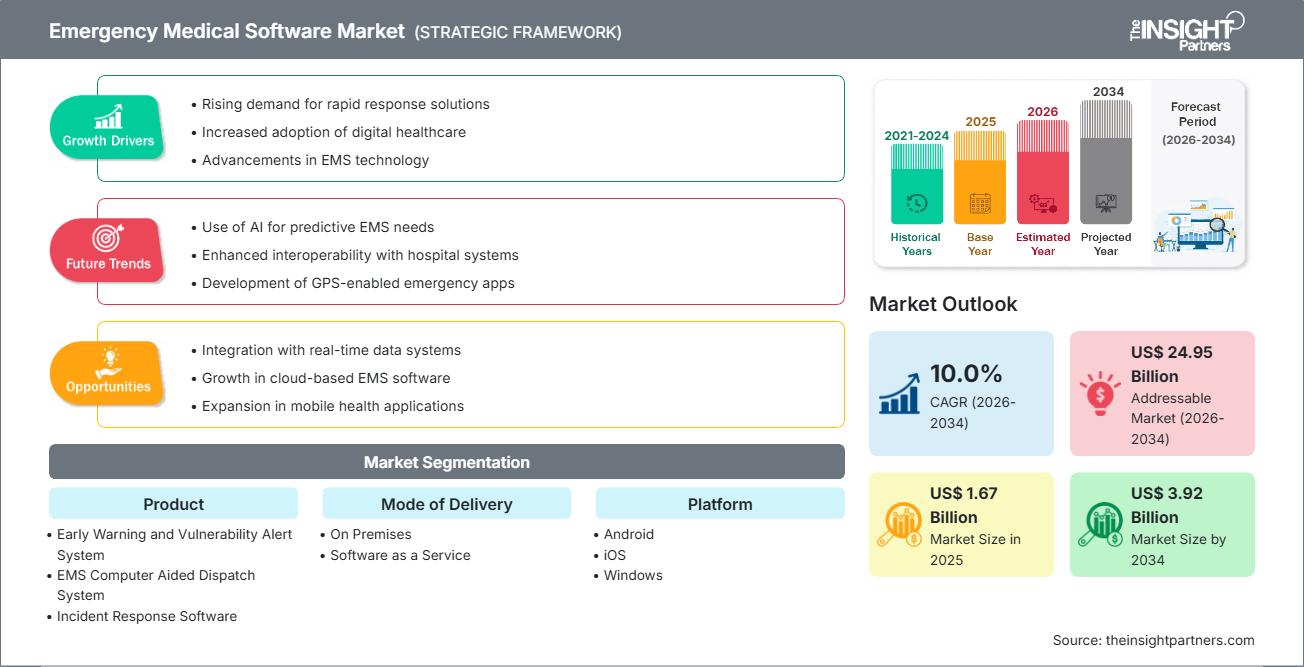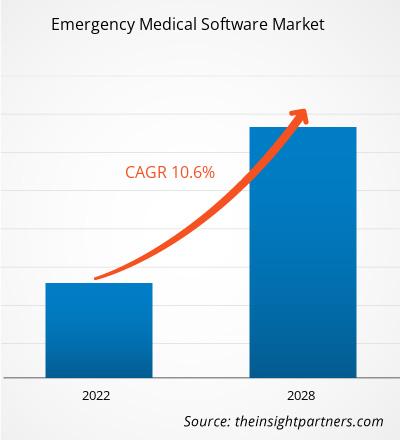预计到2034年,紧急医疗软件系统市场规模将从2025年的16.7亿美元增长至39.2亿美元。预计该市场在2026年至2034年期间的复合年增长率将达到10.0%。
紧急医疗软件市场分析
受创伤事件发生率上升、医疗保健支出增加以及对快速协调的应急响应系统需求日益增长的推动,紧急医疗软件市场正在快速扩张。计算机辅助调度(CAD)、救护车管理软件、预警系统、事件响应软件、本地部署和SaaS交付模式以及移动平台等技术正被越来越多地采用。
急救医疗软件市场概览
紧急医疗软件的实施使医院、医疗服务提供商、急救机构以及市级和州级机构能够简化运营流程,例如调度、救护车管理、患者追踪、计费、数据采集以及跨机构沟通。由于创伤和紧急救援对时间要求极高,这些软件系统有助于缩短响应时间,协调多方参与(急救人员、医院、运输服务),更高效地管理资源,并采集关键患者数据以改善治疗效果。随着医疗数字化、移动平台和云/SaaS交付模式的蓬勃发展,对功能强大的紧急医疗软件解决方案的需求持续增长。
根据您的需求定制此报告
您可以免费获得任何报告的定制服务,包括本报告的部分内容、国家/地区层面的分析、Excel 数据包,以及面向初创企业和高校的优惠折扣。
急救医疗软件市场:战略洞察

-
获取本报告的主要市场趋势。这份免费样品将包含数据分析,内容涵盖市场趋势、估算和预测等。
急救医疗软件市场驱动因素和机遇
市场驱动因素:
- 全球范围内创伤性损伤和紧急医疗需求的发生率不断上升,这增加了对协调应急响应软件的需求。
- 增加医疗保健支出,重点改善紧急医疗基础设施,尤其是在中低收入国家。
- EMS机构和医院迅速采用数字医疗、移动和云解决方案,使软件部署更加可行和可扩展。
市场机遇:
- 基于云和 SaaS 的紧急医疗软件交付方式可以提供可扩展、经济高效的解决方案,尤其适用于市政当局和小型 EMS 机构。
- 将人工智能和移动平台等先进技术集成到急救医疗软件中,是一个新兴的机遇。
- 软件供应商拓展到新兴市场,这些市场的EMS基础设施正在升级,这为其提供了增长潜力。
急救医疗软件市场报告细分分析
本报告对急救医疗软件市场份额进行了多维度分析,旨在更清晰地展现其结构、增长潜力及新兴趋势。以下是大多数行业报告中常用的标准细分方法:
按产品/软件类型:
- 预警和脆弱性警报系统:能够及早发现关键事件,向医疗保健提供者发出警报,并支持对紧急情况和灾难情况做出积极响应。
- EMS 计算机辅助调度系统:实现调度操作自动化,跟踪紧急呼叫,分配资源,并改善调度员、救护车和医院之间的实时协调。
- 事件响应软件:简化紧急情况下的协调,管理多个响应团队和医疗机构之间的沟通、数据共享和任务分配。
- 救护车管理软件:优化救护车跟踪、路线规划、资源分配和病人数据管理,以实现更快、更高效的紧急医疗响应。
通过调制解调器交付:
- 本地部署:在医疗保健或 EMS 基础设施内本地部署,提供完整的数据控制、高安全性和可定制的操作配置。
- 软件即服务:基于云的解决方案,可在分布式 EMS 网络中提供实时访问、可扩展性、远程更新和经济高效的部署。
按平台划分:
- 安卓
- iOS
- 视窗
按最终用户:
- 商业的
- 市政
- 州市机构
按地理位置:
- 北美
- 欧洲
- 亚太
- 南美洲和中美洲
- 中东和非洲
紧急医疗软件市场区域洞察
The Insight Partners 的分析师对预测期内影响急救医疗软件市场的区域趋势和因素进行了详尽的阐述。本节还探讨了北美、欧洲、亚太、中东和非洲以及南美和中美洲等地区的急救医疗软件市场细分和地域分布。
急救医疗软件市场报告范围
| 报告属性 | 细节 |
|---|---|
| 2025年市场规模 | 16.7亿美元 |
| 到2034年市场规模 | 39.2亿美元 |
| 全球复合年增长率(2026-2034 年) | 10.0% |
| 史料 | 2021-2024 |
| 预测期 | 2026-2034 |
| 涵盖部分 |
副产品
|
| 覆盖地区和国家 |
北美
|
| 市场领导者和主要公司简介 |
|
急救医疗软件市场参与者密度:了解其对业务动态的影响
受终端用户需求不断增长的推动,急救医疗软件市场正快速发展。终端用户需求增长的驱动因素包括消费者偏好的转变、技术的进步以及消费者对产品优势的认知度提高。随着需求的增长,企业不断拓展产品和服务,创新以满足消费者需求,并把握新兴趋势,这些都进一步推动了市场增长。

- 获取急救医疗软件市场主要参与者概览
按地域划分的急救医疗软件市场份额分析
北美地区占据最大的市场份额,这主要得益于不断增长的紧急呼叫量、对运营效率日益增长的需求,以及不断变化的监管要求(这些要求强调先进的计费和管理解决方案)。与此同时,亚太地区预计将实现最快的增长,这得益于医疗基础设施的快速现代化、紧急服务利用率的提高以及该地区医疗系统加速推进的数字化转型举措。
由于创伤病例增加和医疗保健支出上升等因素,急救医疗软件市场在不同地区的增长轨迹各不相同。以下是各地区市场份额和趋势概述:
1. 北美洲
- 市场份额:由于先进的 EMS 基础设施、高度数字化、大量的 EMS 呼叫以及强大的医疗保健 IT 投资,该公司历来在紧急医疗软件市场处于领先地位。
- 主要驱动因素:EMS 软件解决方案的高普及率、主要软件和 EMS 供应商的存在、急救技术强大的监管和资金环境。
- 趋势:移动调度、云/SaaS EMS 系统、与医院和运输系统的互操作性等方面的使用日益增多。
2. 欧洲
- 市场份额:由于医疗保健系统成熟以及监管机构对数字化急救医疗服务和医疗保健IT解决方案的推动,市场规模巨大。
- 主要驱动因素:监管举措、EMS升级资金以及某些地区的跨境EMS合作。
- 趋势:采用云端EMS解决方案、多语言平台支持、车队/救护车管理集成度提高。
3. 亚太地区
- 市场份额:受印度、中国和东南亚等国家 EMS 基础设施升级、创伤/事故率上升以及医疗保健 IT 采用率提高的推动,该地区增长速度更快。
- 主要驱动因素:政府在数字医疗领域的举措、智能手机/移动设备在急救医疗服务通信中的普及率不断提高,以及私人急救医疗服务的增长。
- 趋势:移动优先的 EMS 调度和救护车跟踪软件、与区域 EMS 提供商的合作、紧急护理移动应用程序。
4. 南美洲和中美洲
- 市场份额:新兴地区,对EMS技术的投资不断增长,私人EMS部署也在增加。
- 主要驱动因素:私营急救服务提供商越来越多地采用调度和救护车管理软件,区域急救基础设施现代化。
- 趋势:基于云的 EMS 软件模式适合预算有限的机构,对车辆跟踪和患者记录解决方案的需求不断增长。
5. 中东和非洲
- 市场份额:随着各国政府对急救医疗服务体系和数字医疗的投资,该领域展现出增长潜力。
- 主要驱动因素:国家紧急医疗服务计划、私人救护车服务的增长以及数字化调度和救护车软件的采用。
- 趋势:专为多语言/多元文化 EMS 运营量身定制的软件套件、移动 EMS 指挥解决方案、与远程医疗和保险系统的集成。
急救医疗软件市场参与者密度:了解其对业务动态的影响
由于全球大型技术供应商以及新兴的利基市场参与者和专业初创公司的加入,急救医疗软件市场竞争日趋激烈。各公司都在积极创新,以巩固市场地位,并满足各行业对智能决策平台日益增长的需求。
竞争格局促使供应商通过以下方式实现差异化:
- 主要供应商正通过创新、云交付模式、移动平台和分析来推动扩张。
- 差异化优势体现在为急救医疗服务机构提供的调度协调、救护车跟踪、实时数据共享、计费和报告等软件功能上。
- 监管和互操作性标准的重要性日益凸显;提供可扩展、合规解决方案的供应商可能会获得更多机会。
机遇与战略举措
- EMS 软件供应商可以利用市场对高度互联的实时 EMS 系统日益增长的需求,这些系统集成了调度、救护车管理、医院通信、患者数据采集和结果跟踪等功能。
- 采用基于云的部署方式,规模较小的急救机构/市政当局无需大量前期基础设施投资即可采用先进的软件。
- 向急救医疗服务基础设施不足的新兴市场扩张具有很高的增长潜力——供应商可以与当地的急救医疗服务机构或政府合作。
- 将人工智能和分析技术集成到 EMS 软件中,用于预测调度、资源优化、病人分诊和结果测量,可以创造新的价值主张。
在急救医疗软件市场运营的主要公司有:
- Quark软件
- Sun Ridge Systems, Inc.
- 空中飞人集团
- Cerner公司
- GE医疗
- 中央广场
- Traumasoft
- AngelTrack LLC
- EMIS 健康
- 医疗主机
急救医疗软件市场新闻及最新动态
- 例如,领先的电子病历和医疗保健IT解决方案提供商MEDHOST于2025年11月6日宣布EDIS 2024 R1版本正式发布。该最新版本进行了多项重大改进,旨在优化临床工作流程、提高互操作性并符合最新的联邦医疗保健数据标准。
- 2025年10月20日,GE医疗宣布与美国两家领先的医疗系统——皇后医疗系统(The Queen's Health Systems)展开合作,共同推进GE医疗全新人工智能驱动型医院运营软件的开发。两家医疗系统计划贡献其一线经验,为GE医疗即将推出的云优先软件即服务(SaaS)解决方案提供信息支持。该解决方案将成为GE医疗CareIntellect应用套件的一部分。
- 2024年1月,全球垂直市场软件供应商N. Harris Computer Corporation收购了电子健康记录(EHR)和医疗保健IT解决方案领域的领先企业MEDHOST, Inc.,从而增强了其医疗保健产品组合。此次收购还包括MEDTEAM Solutions,这是一家专注于应用、收入周期、IT和安全管理的服务提供商。
急救医疗软件市场报告涵盖范围及成果
《急救医疗软件市场规模及预测(2021-2034)》报告对市场进行了详细分析,涵盖以下领域:
- 本报告涵盖全球、区域和国家层面的紧急医疗软件市场规模及预测,包括所有关键细分市场。
- 紧急医疗软件市场趋势,以及驱动因素、制约因素和关键机遇等市场动态
- 详细的PEST和SWOT分析
- 急救医疗软件市场分析,涵盖关键市场趋势、全球和区域框架、主要参与者、法规以及近期市场发展动态。
- 行业格局及竞争分析,涵盖市场集中度、热力图分析、主要参与者以及急救医疗软件市场的最新发展。提供详细的公司简介。
- 历史分析(2 年)、基准年、预测(7 年)及复合年增长率
- PEST和SWOT分析
- 市场规模、价值/数量 - 全球、区域、国家
- 行业和竞争格局
- Excel 数据集
近期报告
客户评价
购买理由
- 明智的决策
- 了解市场动态
- 竞争分析
- 客户洞察
- 市场预测
- 风险规避
- 战略规划
- 投资论证
- 识别新兴市场
- 优化营销策略
- 提升运营效率
- 顺应监管趋势






















 获取免费样品 - 紧急医疗软件市场
获取免费样品 - 紧急医疗软件市场